Diving into the world of Formula 1 simulation requires more than just a powerful computer and a quality racing wheel. The foundation of an immersive and effective driving experience is the simulator cockpit itself. This essential piece of hardware provides the stability, correct ergonomics, and mounting solutions necessary to translate virtual racing into a tangible skill. Moving from a desk-mounted wheel to a dedicated cockpit is a significant step for any enthusiast aiming to improve their consistency and feel more connected to their sim racing games.
This guide provides a purely informational, technical breakdown of prominent F1-style simulator cockpits. We will explore their construction, core features, and intended applications to provide a clear understanding of how they differ and which user profiles they are best suited for.
Understanding the Core Components of an F1 Simulator Cockpit
Before analyzing specific models, it’s crucial to understand the key features that define a simulator cockpit’s performance and usability. A well-designed cockpit is far more than a chair; it’s an integrated system.
- Chassis Rigidity: The frame’s ability to resist flex under heavy braking and forceful steering inputs. Materials like carbon steel are common. High rigidity is essential for accurately transmitting feedback from direct drive wheels and load cell pedals.
- Seating Position: Simulators typically offer a GT position (upright), a Formula position (low, reclined), or a hybrid design that can switch between the two. The correct position is vital for comfort during long sessions and for muscle memory development.
- Adjustability: The degree to which the seat, pedal plate, and wheel deck can be moved. Proper adjustability ensures users of all sizes can achieve an optimal ergonomic setup, preventing strain and improving control.
- Compatibility: The cockpit must have pre-drilled mounting points that align with major hardware brands like Logitech, Thrustmaster, and Fanatec. This ensures wheels, pedals, and shifters can be securely attached.
- Footprint and Storage: The physical space the cockpit occupies. Some models are large and heavy, designed for dedicated spaces, while others feature foldable designs for users with limited room.
Expert Analogy: Choosing a sim cockpit is like selecting a car’s chassis. A lightweight, foldable frame is akin to a road car’s chassis—convenient and functional, but with compromises in ultimate performance. A heavy, rigid, fixed frame is like a race car’s chassis—uncompromisingly stiff for maximum feedback and control, but requiring a dedicated space.
Comparative Analysis of Leading F1 Simulator Cockpits
For a quick overview, the following table compares the key specifications of the five models analyzed in this guide. This data-driven comparison allows for an at-a-glance understanding of their primary features and differences.
| Feature | OpenWheeler GEN3 | Next Level Racing GT Lite (NLR-S021) | Next Level Racing F-GT Lite (NLR-S015) | Next Level Racing GT Track (NLR-S009) | Extreme Simracing V 3.0 |
| Primary Material | Carbon Steel | Carbon Steel, Breathable Fabric | Carbon Steel, Breathable Fabric | Carbon Steel | Carbon Steel |
| Primary Position | GT/Formula Hybrid | GT | Formula & GT | GT | GT/Formula Hybrid |
| Foldable Design | No | Yes | Yes | No | No (Folding Seat) |
| Wheel/Pedal Mount | Pre-drilled | Pre-drilled | Pre-drilled | Pre-drilled | Pre-drilled |
| Compatibility | Logitech, Thrustmaster, Fanatec | Logitech, Thrustmaster, Fanatec | Logitech, Thrustmaster, Fanatec | Logitech, Thrustmaster, Fanatec | Logitech, Thrustmaster, Fanatec |
| Max Supported Weight | Not Specified | 130 kg (287 lbs) | 130 kg (287 lbs) | 150 kg (330 lbs) | 154 kg (340 lbs) |
| Gear Shifter Mount | Included | Included | Included | Included | Included |
| Included TV Stand | Yes | No | No | No | Yes |
| Product Weight | ~35 kg (77 lbs) | 14.4 kg (31.7 lbs) | 19 kg (42 lbs) | 48 kg (106 lbs) | ~52 kg (114.6 lbs) |
| Target User | All-in-One Beginner | Space-Conscious Beginner | Versatile Beginner | Serious Enthusiast / Pro | All-in-One Intermediate |
Detailed Breakdown of Top F1 Simulator Cockpits
Here we examine the construction, features, and specific design elements of each cockpit, providing an objective analysis for prospective users.
OpenWheeler GEN3 Racing Wheel Simulator
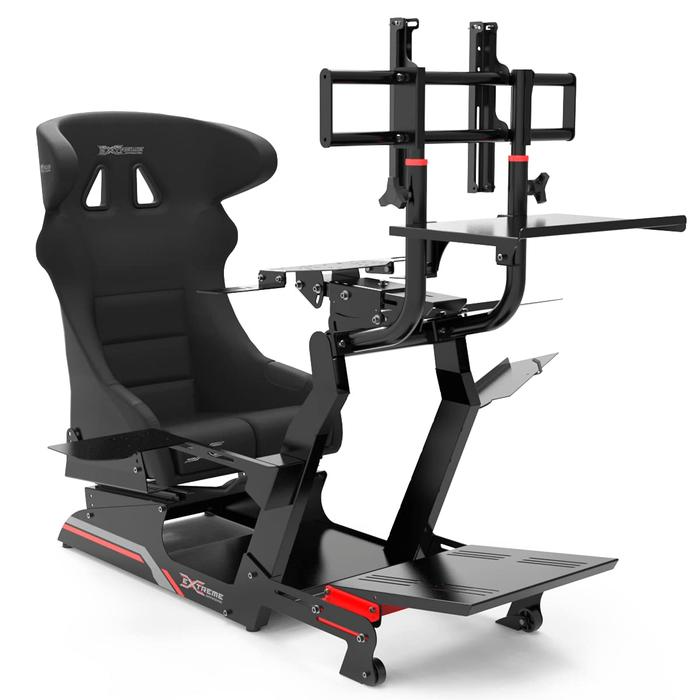
The OpenWheeler GEN3 is a comprehensive package designed as an all-in-one solution. Its chassis is constructed from carbon steel, providing a stable platform for entry to mid-range wheel and pedal sets. A key feature is the inclusion of numerous accessories out of the box, such as a TV stand, gear shifter mount, and a keyboard tray.
The seat is a wide, padded design intended for comfort over extended periods. Adjustability is present in the seat sliders and the angle of the pedal plate. This model attempts to provide everything a user needs to get started in one package, making it suitable for those who want a complete setup without sourcing individual components.
- Key Features:
- All-in-one package with TV stand and accessories.
- Carbon steel frame.
- Padded, wide racing seat with sliders.
- Adjustable pedal plate for angle and distance.
Next Level Racing GT Lite Foldable Simulator Cockpit (NLR-S021)
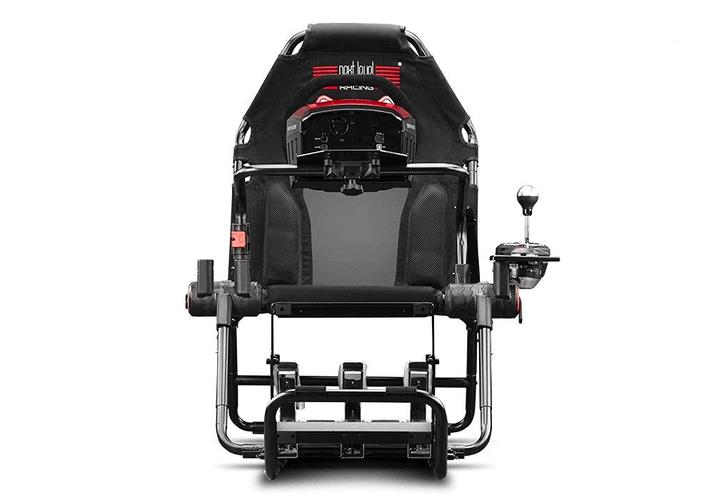
The GT Lite (NLR-S021) focuses on addressing the challenge of limited space. Its primary design feature is its foldability, allowing it to be stored away even with peripherals like a Logitech G920 or Thrustmaster wheel attached. The core of this functionality lies in the Next Level Racing Hubs, which are load-tested to withstand 150 kg of force, providing rigidity at key pivot points.
This cockpit is configured for a GT-style seating position. The seat itself is made from a breathable fabric to enhance comfort during use. It offers adjustability for the wheel, pedal, and shifter positions and comes pre-drilled for all major hardware brands. Its lightweight and portable nature make it an option for casual racers or those without a dedicated sim racing area.
- Key Features:
- Foldable design for easy storage.
- Patented hub system for quick adjustments and rigidity.
- Dedicated GT seating position.
- Breathable fabric seat.
- Pre-drilled for all major wheel and pedal brands.
Next Level Racing F-GT Lite Simulator Cockpit (NLR-S015)
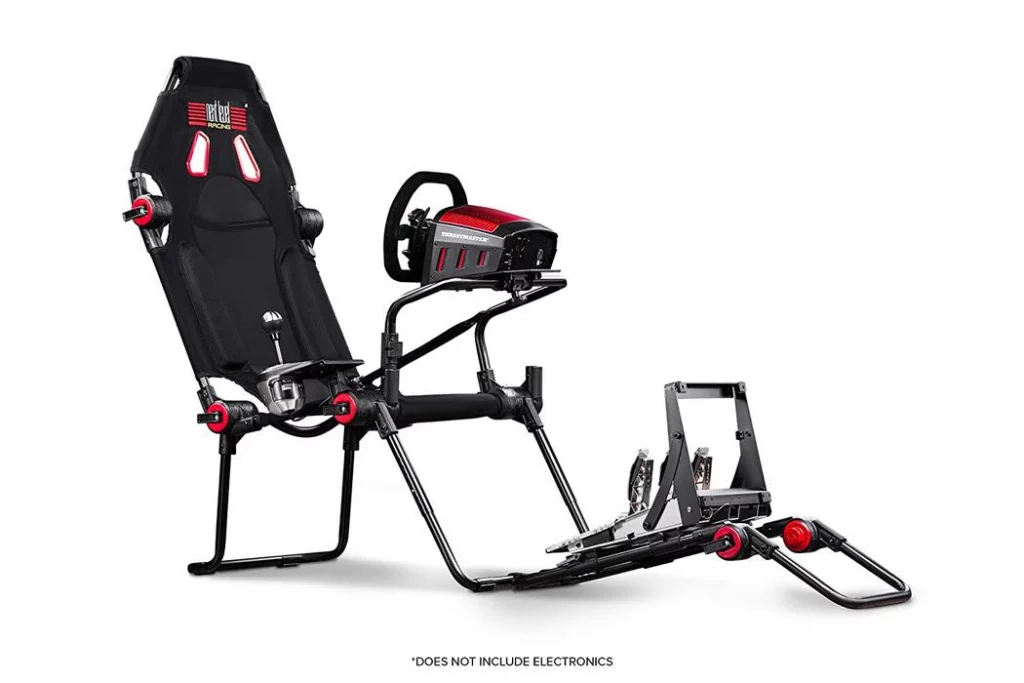
Similar to its GT Lite sibling, the F-GT Lite (NLR-S015) is built around the same foldable chassis concept and patented hub system. The defining difference is its ability to switch between two distinct seating positions: an upright GT style and a low-slung, reclined Formula style. This versatility allows users to experience different racing disciplines with more appropriate ergonomics.
The quick-release mechanism of the hubs facilitates the transition between positions. Like the GT Lite, it is pre-drilled for hard mounting wheels, pedals, and shifters from major brands like Logitech, Thrustmaster, and Fanatec. This model is engineered for users who enjoy both F1 and GT racing but still require a compact, storable solution. A proper F1 game setup can benefit greatly from its authentic seating posture.
- Key Features:
- Revolutionary design allowing for both Formula and GT racing positions.
- Foldable for compact storage.
- Durable hubs tested to 150 kg of force.
- Highly adjustable to find a comfortable position.
- Includes gear shifter support.
Next Level Racing GT Track Cockpit (NLR-S009)
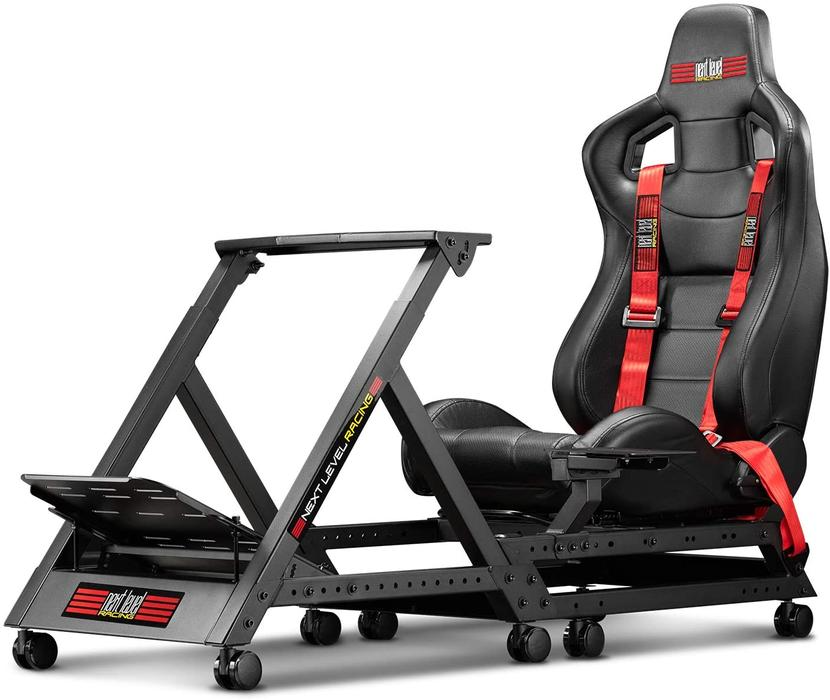
The GT Track (NLR-S009) represents a significant step up in rigidity and features, targeting serious sim racers and professionals. It is a non-foldable, heavy-duty cockpit constructed from carbon steel using laser cutting and robotic welding. This robust construction makes it suitable for high-end, direct drive wheels and professional-grade pedal sets that exert significant force.
It comes equipped with a reinforced racing bucket seat, a four-point racing harness, and lockable castor wheels for mobility. Crucially, it is designed for motion platform integration, being fully compatible with the Next Level Racing Motion Platform V3 and Traction Plus systems. This focus on strength and expandability places it in a higher performance category.
- Key Features:
- Extremely rigid carbon steel chassis.
- Designed to support direct drive wheels and professional pedals.
- Includes racing bucket seat, harness, and shifter/handbrake support.
- Fully compatible with Next Level Racing motion platforms.
- Used by professional drivers and esports champions.
Extreme Simracing Cockpit V 3.0
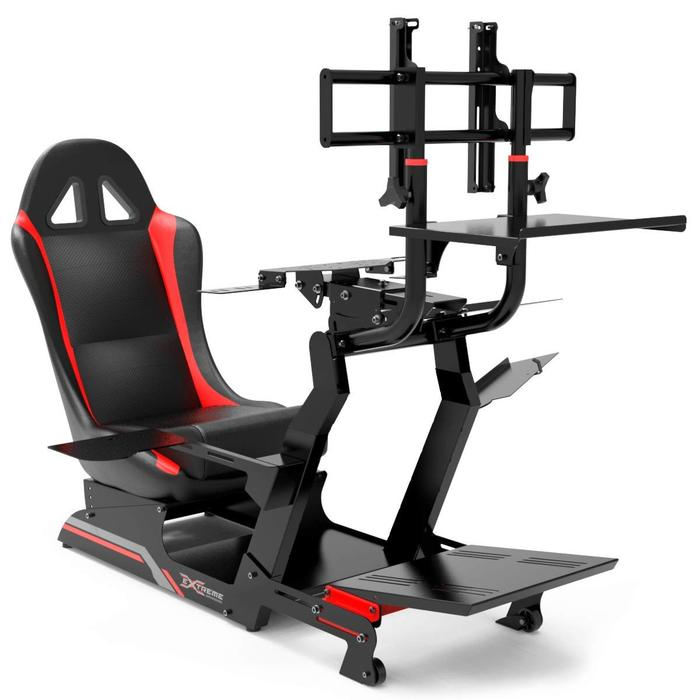
The Extreme Simracing Cockpit V 3.0, much like the OpenWheeler, is presented as a full-featured package. Its carbon steel chassis is engineered to handle direct drive wheels and load cell pedals, indicating a focus on stability. The unit includes an integrated TV stand compatible with screens up to 55 inches, a back tray for a PC or console, and multiple shifter and handbrake mounting options.
A unique feature is the folding design of the seat itself, which can be reclined for non-racing activities, adding a layer of versatility. The pedal plate and wheel deck are highly adjustable in terms of angle, distance, and height. With its robust build and comprehensive set of included accessories, this cockpit is aimed at intermediate users who want a solid, all-inclusive platform.
- Key Features:
- Reinforced carbon steel chassis ready for direct drive wheels.
- Complete package with integrated TV stand and multiple accessory trays.
- Folding/reclining seat design.
- Fully adjustable wheel and pedal plates.
- Supports a high maximum weight.
Key Factors in Selecting the Right Simulator Cockpit
Choosing the appropriate model depends entirely on individual needs and circumstances. Consider these factors based on the technical information provided.
Seating Position: Formula vs. GT
Your preferred racing style is a primary determinant. If you exclusively race F1 cars, a cockpit that excels in the low, reclined Formula position, like the F-GT Lite, is ideal. If you primarily race sports cars, a GT-focused cockpit like the GT Lite or GT Track is more suitable. Hybrid models offer flexibility but may involve compromises compared to a dedicated design.
Material and Rigidity: The Foundation of Performance
The material and construction directly impact your experience.
For users with entry-level, gear- or belt-driven wheels (e.g., Logitech G923), a foldable cockpit like the GT Lite or F-GT Lite offers sufficient rigidity. However, if your sim racing setup guide includes a direct drive wheelbase (e.g., Fanatec CSL DD), the immense torque necessitates a rigid, non-foldable frame like the GT Track to prevent flex and ensure all force feedback is transmitted accurately.
Adjustability and Ergonomics
A cockpit must fit your body. Look for extensive adjustment ranges in the seat position (sliders, angle), wheel deck (height, angle), and pedal plate (distance, angle). A rig that allows you to replicate the ergonomics of a real car will be more comfortable and will help build more effective muscle memory, ultimately making you faster in sim racing.
Space and Portability
The most critical logistical factor is space. A model like the GT Track is a permanent fixture. For apartment dwellers or those with multi-use rooms, a foldable design like the F-GT Lite or GT Lite is the only practical option. Measure your available space carefully and compare it against the cockpit’s assembled footprint.
Frequently Asked Questions (FAQ)
What is the most important part of a Formula 1 simulator cockpit?
While every part is integral, chassis rigidity is arguably the most critical. A rigid frame ensures that all feedback from the wheel and pedals is transmitted directly to the user without being absorbed or lost through chassis flex. This is especially true when using powerful direct drive wheels.
Can I use a GT-style cockpit for F1 racing?
Yes, you can absolutely use a GT-style cockpit for F1 games. However, a dedicated Formula-style seating position provides a more authentic and immersive experience that more closely mimics the real-world driving posture, which can aid in performance.
Are integrated monitor stands a good feature?
Integrated monitor stands, like those on the OpenWheeler and Extreme Simracing models, offer a convenient all-in-one solution. However, separate, freestanding monitor stands (like a dual monitor stand) can offer more flexibility in positioning and may help isolate the monitors from vibrations generated by the wheelbase and the driver.
How much does a good F1 simulator setup cost?
The cost can vary dramatically. A basic setup with an entry-level foldable cockpit and a Logitech wheel might cost a few hundred dollars. A high-end setup with a rigid cockpit like the GT Track, a direct drive wheel, professional pedals, and motion systems can easily exceed several thousand dollars. For a detailed breakdown, exploring a sim racing setup cost guide is beneficial.
Do I need a PC for these simulators?
All the cockpits listed are hardware platforms compatible with wheels and pedals for both PC and consoles (PlayStation, Xbox). Your choice of platform will depend on the sim racing games you wish to play, as some titles are exclusive to PC.

With a background in mechanical engineering and over a decade in competitive sim racing, Kenji serves as our lead Sim Racing Physics & Hardware Analyst. He deconstructs complex topics like force feedback and suspension geometry, helping readers understand the crucial engineering behind a perfect lap time. Kenji’s passion is to translate real-world motorsport principles into actionable knowledge for the sim racing community.
